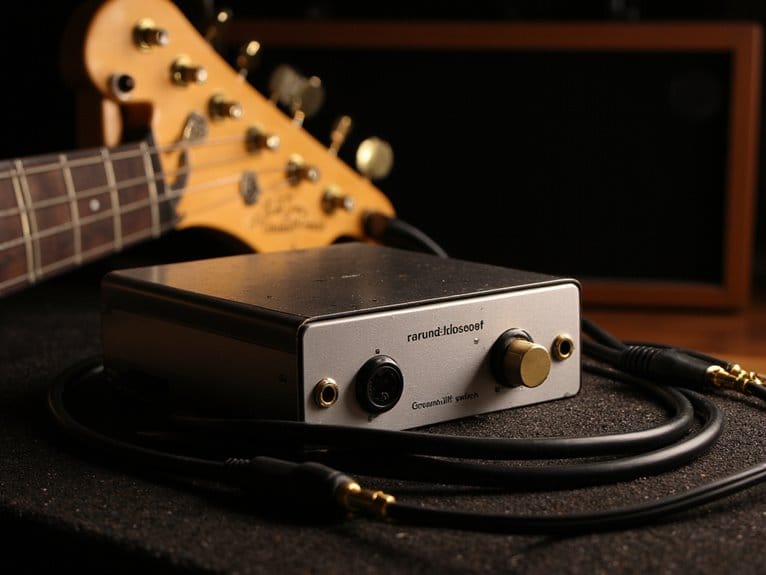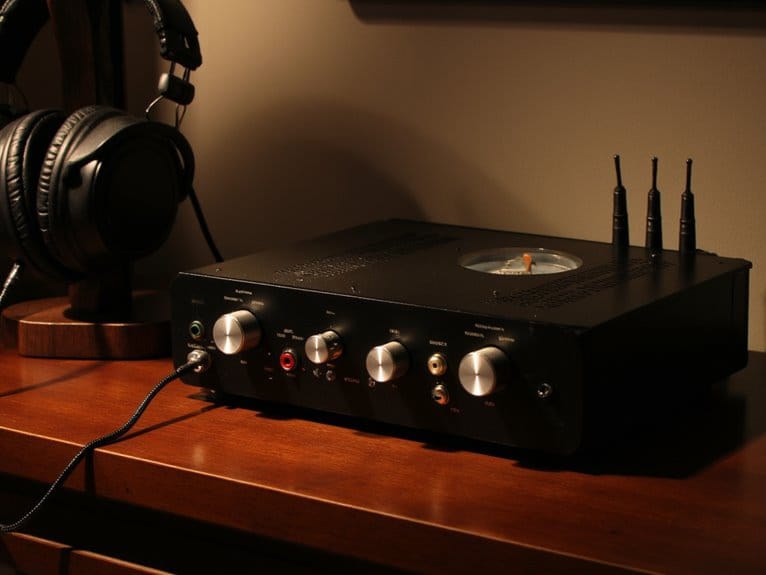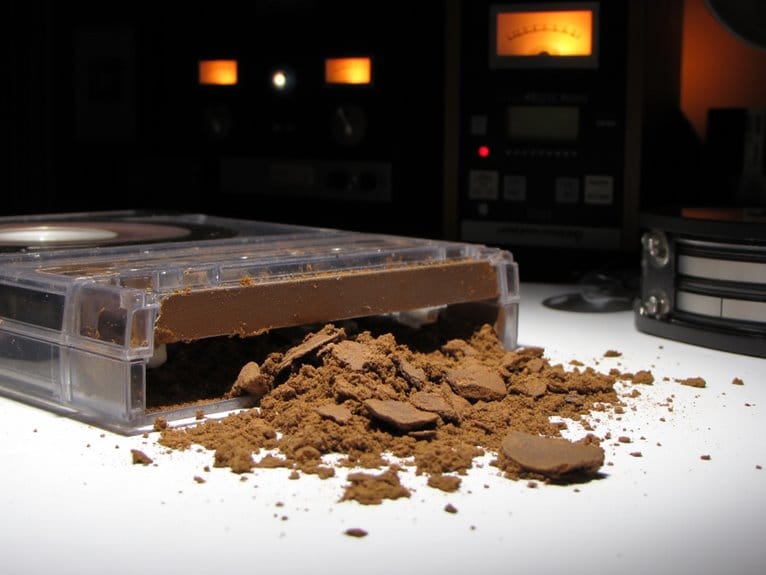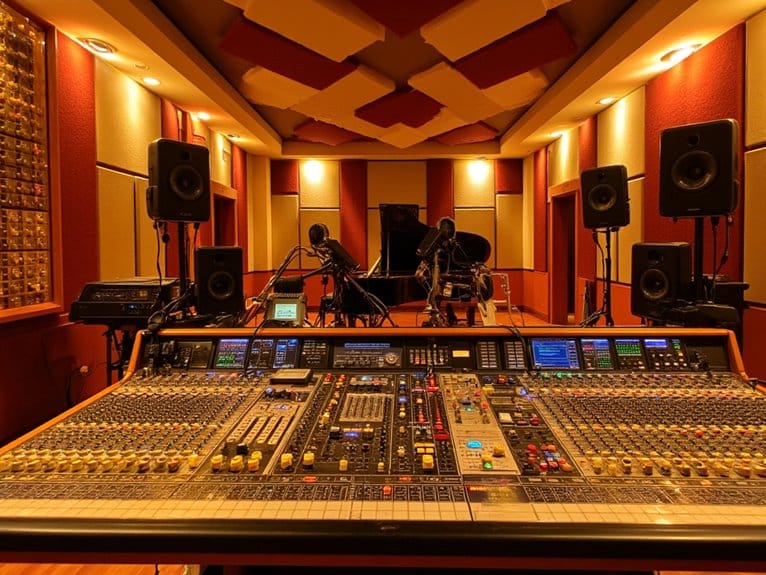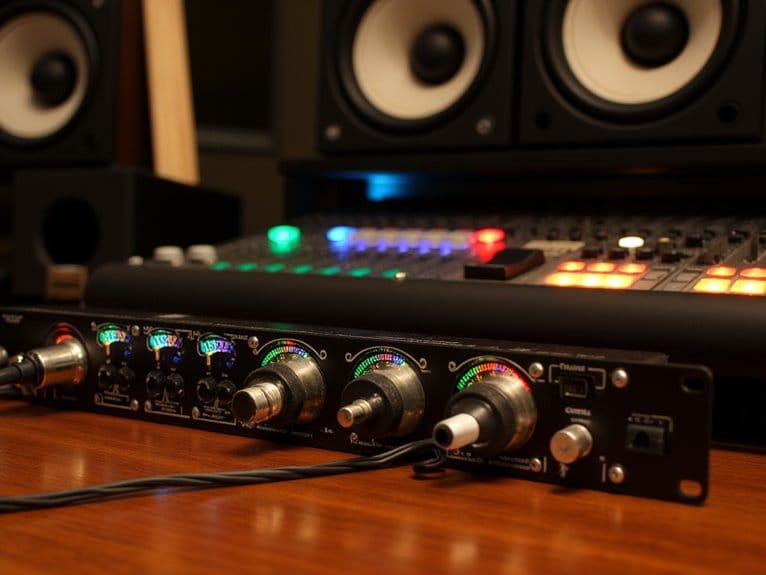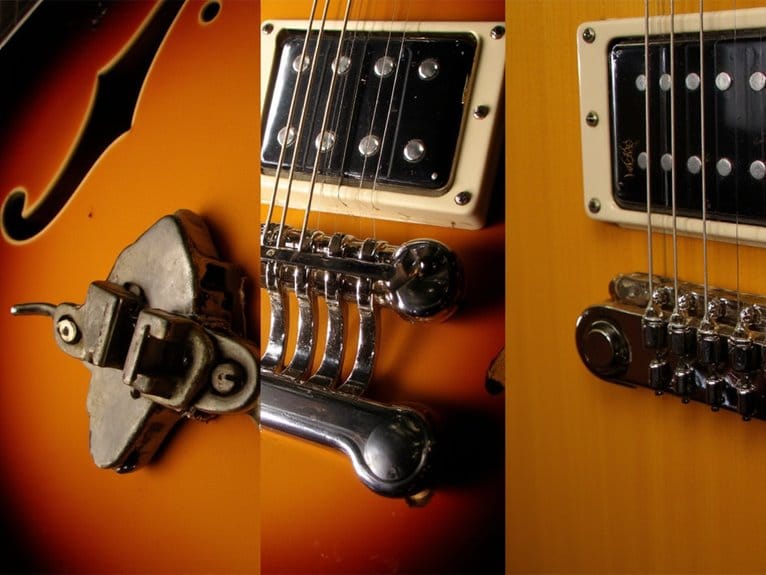Understanding Bass Guitar DI Boxes and Their Importance
A bass guitar DI box converts your instrument’s high-impedance, unbalanced signal into a low-impedance, balanced output that mixing consoles and audio interfaces can properly handle. You’ll need this conversion because it eliminates noise, reduces interference over long cable runs, and matches your bass’s output to professional gear’s 100-200Ω input requirements. Passive DI boxes work best with high-output instruments, while active units amplify weaker vintage bass signals. Understanding these fundamentals will help you make informed decisions about signal routing and equipment selection.
We are supported by our audience. When you purchase through links on our site, we may earn an affiliate commission, at no extra cost for you. Learn more.
Notable Insights
- DI boxes convert bass guitar’s high-impedance signal to balanced, low-impedance output for professional audio equipment compatibility.
- Passive DI boxes suit high-output basses while active DI boxes provide preamplification for vintage basses with weak pickups.
- Direct injection preserves signal quality, reduces noise interference, and maintains bass tone integrity over long cable distances.
- Essential DI features include high-impedance input, balanced XLR output, ground lift switch, and reliable thru output for amplifiers.
- DI boxes enable simultaneous amp and mixing console feeds, providing backup recording tracks and enhanced live sound control.
What Is a Bass Guitar DI Box and How Does It Work
The humble DI box mightn’t look like much—just a small metal box with a few connectors—but it’s actually one of the most essential tools in any bassist’s arsenal, quietly transforming your instrument’s raw signal into something that professional audio equipment can actually work with.
When you plug your bass into a DI box, it converts your guitar’s unbalanced, high-impedance signal into a balanced, low-impedance output that mixing consoles prefer.
Signal balancing eliminates noise and interference over long cable runs, while the impedance conversion guarantees proper level matching. This impedance bridging typically converts your bass’s 50 kΩ signal down to the 100–200 Ω mic input levels that professional mixing boards expect.
Most DI box connections feature a ¼-inch input for your bass and an XLR output for professional gear, creating that clean, interference-free sound engineers love. DI boxes also provide ground lift switches that help eliminate unwanted noise and hum in your signal chain.
Passive Vs Active DI Boxes: Key DIfferences and Applications
When you’re standing in front of two DI boxes—one passive, one active—the choice between them isn’t just about preference, it’s about understanding how each type handles your bass signal in fundamentally different ways.
Passive advantages include their transformer-based design that eliminates ground loop hum naturally, requires no power source, and imparts that subtle vintage saturation when you drive them hard. Quality passive DIs use high-performance transformers for effective interference elimination and achieve ultra-flat frequency response. Transformer DI boxes use magnetic coils for electrical isolation, producing a warmer tone that’s particularly ideal for high-output instruments.
Active DI boxes offer preamplification for weak signals and longer cable runs, though active limitations include potential noise from circuitry and power dependency. These units are particularly valuable for single-coil pickups that need the extra support for longer cable runs. Professional active units provide precise tonal control through built-in EQ options and feedback management capabilities.
Your bass’s output level determines the best match: high-output instruments benefit from passive units, while vintage basses with weak pickups need active amplification to maintain signal integrity.
Technical Benefits of Direct Injection for Bass Guitar
When you connect your bass directly to an amplifier or mixing console, you’re likely experiencing signal degradation that could be dramatically improved through proper direct injection techniques.
The technical benefits of using a DI box extend far beyond simple connectivity, as these devices fundamentally transform your instrument’s electrical characteristics to optimize signal transfer, reduce noise interference, and maintain the integrity of your bass’s natural tone throughout the entire audio chain.
Understanding how impedance matching and signal quality enhancement work together will help you make informed decisions about incorporating DI boxes into your setup, whether you’re recording in the studio or performing live on stage.
Signal Quality Enhancement
Professional audio engineers consistently emphasize that signal quality forms the foundation of exceptional bass recordings and live performances, which explains why direct injection boxes have become indispensable tools in modern music production.
When you’re dealing with bass frequencies, signal clarity becomes paramount because low-end information carries significant energy that’s easily compromised by interference. DI boxes excel at noise elimination through their balanced output design, which actively rejects electrical interference that would otherwise muddy your bass tone.
I’ve observed that unbalanced signals degrade noticeably beyond six meters, while balanced DI outputs maintain pristine quality over distances exceeding 100 meters. The ground lift switches found on quality DI boxes eliminate ground loop hum, ensuring your bass signal reaches mixing consoles with remarkable purity and dynamic range intact.
Modern bass preamps with built-in DI capabilities, such as the Tech 21 SansAmp VT Bass DI, offer multiple outputs including 1/4-inch, XLR, and parallel connections for seamless integration with various sound systems. Similar to how bass amplifiers benefit from headphone outputs for silent practice, DI boxes with monitor outputs allow bassists to maintain their stage sound while sending a clean signal to the mixing board. Quality DI units also ensure tuning stability during live performances, preventing pitch drift that can occur with inferior signal processing equipment.
Impedance Matching Benefits
Understanding impedance mismatch becomes essential the moment you realize your bass guitar’s high-impedance output, typically ranging from 10,000 to 50,000 ohms, can’t effectively communicate with professional mixing consoles that expect low-impedance signals around 150 to 600 ohms.
This fundamental incompatibility causes immediate signal degradation, resulting in weakened tone, reduced clarity, and noticeable loss of your instrument’s natural character.
DI boxes eliminate this impedance mismatch by converting your bass’s high-impedance signal into the low-impedance format that professional audio equipment demands, ensuring ideal signal transfer without compromising your sound.
The balanced output further reduces electromagnetic interference over long cable runs, while proper impedance matching maintains signal strength and preserves the full frequency spectrum of your bass guitar throughout the entire audio chain.
Essential Features to Look for in a Bass DI Box
Maneuvering the maze of bass DI box specifications can feel overwhelming, but I’ve found that focusing on a handful of core DI box features will guide you toward the right choice for your specific needs.
First, confirm the unit presents a high-impedance input exceeding 250kΩ to preserve your bass’s natural tone without loading the pickups. Look for balanced XLR outputs with ground lift switches, which eliminate hum and provide excellent noise rejection over long cable runs.
A reliable thru output lets you simultaneously feed your amp and mixing console, maintaining signal integrity throughout your entire rig. Just as with DI boxes, quality oxygen-free copper conductors in your connecting cables ensure clean signal transmission from your bass to the DI box without interference.
Consider active models for passive basses, offering superior headroom and clarity, while passive DI boxes excel with active instruments due to their ability to handle higher signal levels without distortion, guaranteeing peak performance stability. Professional DI boxes should support 24-bit/192 kHz resolution to ensure maximum audio fidelity when interfacing with modern recording equipment. Additionally, prioritize DI boxes with durable construction featuring metal chassis and reinforced components to withstand the rigors of frequent gigging and transport.
Live Performance Applications and Advantages
While selecting the right features forms the foundation of your DI box decision, the real magic happens when you plug in for a live performance, where these units transform from simple signal converters into indispensable problem-solvers that address the unique challenges of stage environments.
Your live sound benefits immediately from the balanced XLR outputs that reject interference over long cable runs to the mixing console, while ground lift switches eliminate troublesome hum that can plague complex stage setups.
I’ve found that engineers appreciate receiving clean, standardized signals that simplify gain staging and mixing decisions, particularly in venues where stage volume restrictions matter.
The parallel output maintains your amp’s monitoring capabilities without compromising the front-of-house feed, creating a win-win scenario for both performance comfort and audience experience.
Professional audio interfaces with Class A preamps deliver the clean amplification needed for optimal signal processing before your bass signal reaches the mixing console.
For touring musicians who also record, investing in professional DI boxes with ultra-low latency capabilities ensures seamless workflow whether you’re capturing studio takes or delivering pristine bass signals to front-of-house engineers.
Studio Recording Benefits of Using Bass DI Boxes
When you step into the studio, bass DI boxes become precision instruments that elevate your recordings from good to exceptional. They transform the inherently problematic high-impedance signal from your bass into a robust, balanced feed that studio equipment craves.
I’ve witnessed countless sessions where DI box features like impedance matching and balanced XLR outputs eliminated the hum and interference that plagued direct connections, delivering crystal-clear fundamentals without room coloration.
The recording flexibility you’ll gain is remarkable—your DI track serves as an insurance policy against amp failures while providing clean source material for reamping with different gear later.
You can blend that focused DI clarity with miked amp warmth, creating layered bass tones that cut through dense mixes with surgical precision.
Choosing the Right DI Box for Your Bass Guitar Setup
How do you navigate the maze of DI box options when your bass guitar’s unique characteristics demand a tailored solution? I’ve found that matching your pickup system to the right DI type makes all the difference in achieving ideal signal routing and preserving your instrument’s natural voice.
| Bass Type | Recommended DI | Key DI Box Features |
|---|---|---|
| Passive Bass | Active DI | High input impedance, signal boost |
| Active Bass | Passive/Active DI | Attenuation pad, ground lift |
| Piezo/Hybrid | Specialized DI | Multiple inputs, impedance matching |
Your choice hinges on understanding how passive basses benefit from active DI boxes’ amplification, while active pickups often pair well with passive units that preserve their built-in preamp character without added noise or unnecessary signal processing. The pickup configuration you select fundamentally shapes your bass’s sonic character and determines the optimal DI matching strategy for your specific instrument.
Frequently Asked Questions
Can I Use a Guitar DI Box for My Bass Guitar?
You can use a guitar DI box for your bass guitar, though you’ll notice guitar differences in frequency response. Bass-specific DI boxes better handle low frequencies, providing improved signal clarity for your instrument’s extended range.
Do I Need a DI Box if My Bass Amp Has a Line Out?
You’ll still benefit from a DI box even with your bass amp’s line out. While line out benefits include convenience, bass amp options don’t guarantee proper impedance matching or balanced signals for professional mixing consoles.
Will Using a DI Box Affect My Bass Tone or Sound Quality?
A quality DI box won’t negatively affect your bass tone – it’ll actually preserve tone clarity and sound dynamics. Cheap DI boxes might color your sound, but good ones maintain your instrument’s natural character while improving signal integrity.
How Much Should I Expect to Spend on a Quality Bass DI Box?
You’ll find budget options starting around $40-60 for basic passive DI boxes, while mid-range models cost $150-300. High end choices exceed $300, offering advanced preamps, EQ controls, and premium build quality for professional applications.
On a final note
You’ve now got the knowledge to make an informed decision about bass DI boxes, whether you’re heading into the studio or hitting the stage. Remember, there’s no universal “best” choice – it’s about matching the right DI to your specific bass, playing style, and venue requirements. Don’t overthink it too much; even a basic passive DI will dramatically improve your sound quality and give you professional-level results you’ll appreciate.

